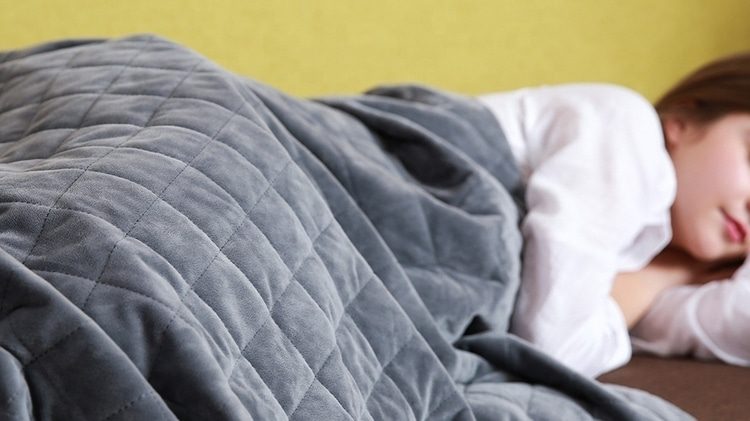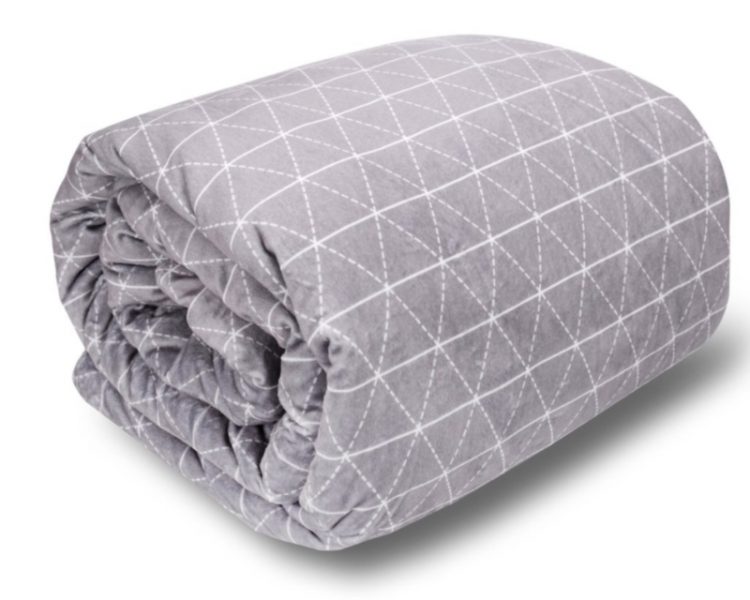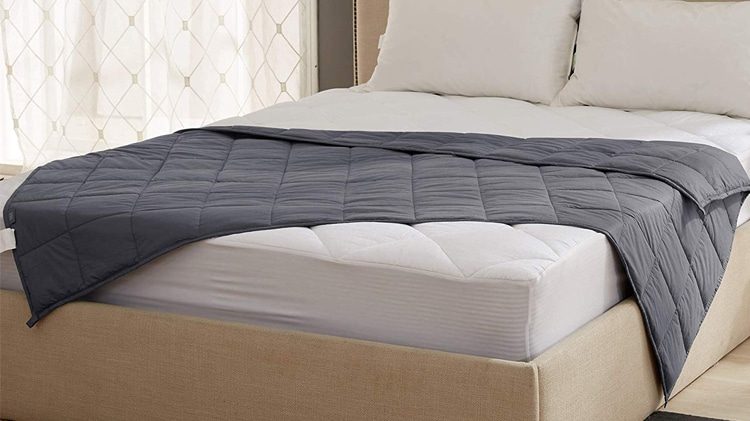If you’re wondering what a weighted blanket is, they are just sleeping blankets that are heavier than regular ones. The extra weight primarily comes from added polymer pellets or glass beads in individual ‘pockets’ quilted into the material by hand.
It’s very significant to pick a weighted blanket that will suit your weight and size. Doing so will ensure that you get the optimum benefits.
As a general rule, a weighted blanket should cover at least 95% of your body and weigh at least 10% of your total body weight. Too little or too much weight and you won’t get the right amount of pressure, pick a wrong size and you could either feel trapped or easily break out from under the blanket.
Weighted blankets help to improve the quality and duration of sleep by a process known as ‘grounding’ or ‘earthing’ using the sheer weight of the material.
The whole idea of ‘grounding’ is to put pressure on the body’s ‘Deep Pressure Touch’ zones to gradually increase the levels of Serotonin and Endorphin – The body’s main sleep-inducing hormones. But you probably shouldn’t get hung up on the technical details at this point.
You may already have some knowledge about these heavier blankets, or you might’ve heard about the numerous benefits of using weighted blankets, but you don’t know how to go about buying one.
This article will guide you through best practices for selecting weighted blankets of the right weight and size while considering all other relevant factors.
Common misconceptions
There is a misconception about weighted blankets that many people share – that weighted blankets are only for people with sleeping problems. Remarkably, regular people could also use some more quality shut-eye.
Another mistake people make has to do with sizing – a weighted blanket is not intended as a duvet, comforter, or a bedspread. It should be a wrap-around blanket for your body.
Determining the correct weight and size for your weighted blanket will depend on your body dimensions, not necessarily the size of your bed. The two primary measures are your height and weight.
Other important factors to consider are your age and the purpose for which you’re buying a weighted blanket. (presence/absence of special needs)
People with special needs like those on the Autism spectrum may require more weight than regular people.
How much do the blankets weigh?
Weighted blankets can weigh anywhere from 5-30 pounds. Before making a selection, you will need to consider the body dimensions of the intended user – The weight and height.
The general rule is for the blanket to be at least 10% of total body weight although personal preference is a factor as well.
Many people report improved sleep using weighted blankets that are well over the 10% margin.
Why you need a heavier blanket
A weighted blanket offers many benefits that a regular sleeping blanket simply can’t provide. From people with psychosocial challenges (e.g. anxiety, depression, and fear) to those with chronic mental health conditions and even regular people who just want to have a better quality sleep at night, weighted blankets offer something for everyone.
I think it’s a worthwhile investment that will improve your overall state of health, well-being, and lifestyle in the longer term. The benefits of using one always outlive the price you pay for it.

Extensive studies and feedback from weighted blanket users have shown that men and women experience comfort using varying weighted blankets for deep pressure therapy.
How heavy could they get?
The heavier ranges of weighted blankets are between 25 and 30 pounds and could feel like a tight hug. There actually isn’t a one-size-fits-all. It’s recommended that you choose a weight that is suitable for your frame.
Some weighted blanket manufacturers insist that weighted of the heavier ranges are ideal for any person regardless of age, but people will often return a blanket if they find it too heavy for comfort.
I’m of the opinion that an overly heavy blanket could act as a restraint which could pose medical and safety issues, especially in younger children and seniors.
Occupational therapists advise that a weighted blanket should be ample enough to weigh you down, but light enough for you to take it off without help.
Pro tip: If a person feels trapped under a weighted blanket, it’s probably too heavy.
Since we lose and gain weight sporadically throughout the year, the best way to choose a weighted blanket is by using your Ideal body weight.
Choosing weighted blankets to suit your Ideal body weight
Choosing weighted blankets based on your ideal body weight is one of the best ways to future-proof your investment.
Your ideal body weight is your optimum healthful weight based on your age, gender and level of physical fitness. It isn’t necessarily what you weigh now, but what you could measure in the future.
Ideal body weight is linked to lean muscle mass. Each person will have a unique value based on the above factors. There’s a simple way for anyone to find out their ideal body weight.
We’ll need to do a little math…
Females
To find out your ideal body weight, you’ll need to find out how many inches over 5 feet you are. If you’re a female less than 5 feet tall, find out how many inches under 5 feet you are.
Multiply the number you get by 5 and add 105 to it. That’s your ideal body weight. If you’re less than 5 feet tall, subtract 105 from the value you got when you multiplied your height by 5.
Males
To find out your ideal body weight, you’ll need to find out how many inches over 5 feet you are. If you’re over 5 feet tall, find out how many inches over 5 feet you are.
Multiply the number you get by 6 and add 106 to it. That’s your ideal body weight. If you’re less than 5 feet tall, deduct 106 from the value you got when you multiplied your height by 6.
Ideal body weight range
We could also get a range of ideal body weight for both sexes. A range of values is useful for providing some leeway since we’re not all built the same. To get your ideal body weight range, simply add or subtract 10% in your calculations.
Custom made blankets
With that in mind, weighted blankets can be custom-made for a user based on their ideal body weight if they can’t find a suitable weight. In this case, calculations are made to take weight loss and weight gain into account over the useful life of the blanket.
How big should my weighted blanket be?
An adequately-sized weighted blanket should be able to swaddle up to 95% of your body, or it isn’t big enough.

Buying weighted blankets is much like getting conventional bedsheets, but it doesn’t need to be the same size as your bed. The original idea was for the whole thing to wrap around your body – to give you a ‘bear hug.’
The blankets should help you feel calm and relaxed in many different postures: You could be laying it across your lap or trunk, wrap it around your shoulders, use it to cover only your feet and a full body covering for sleeping.
Common dimensions
The ubiquitous weighted blankets sizes are small, medium and large sized blankets. They usually measure in inches. The overall spread should have a square or rectangular (more common variant) shape.
The following dimensions should give you some insight on sizes to look out for, but individual preferences are still the strongest buying determinants.
Children
42 – 60 inches long x 38 inches width (length could be more for taller children)
Adults
38 inches x 50 inches for a small weighted blanket
38 inches x 60 inches for the medium size
42 inches x 72 inches for a large blanket
Older people
Same as for adults. Length could be 2-3 inches less or more to account for ‘reduced’ size in people over 65 years of age.
Know your body dimensions
The first step to choosing the right weighted blanket is finding out what your height and weight is. Remember that weighted blankets are intended as a wrap-around for your body, not to cover the entire bed.
You could visit a local clinic or a fitness center to find out your exact height and use a bathroom scale to find out your weight. It’s important to keep those values in mind for when you’ll be choosing a blanket.
Weighted blankets for children
Since weighted blankets could offer a considerable amount of weight, it’s critical that you pay extra attention to size and weight when choosing one for a child.
However, since weighted blankets could be a substantial investment, you’ll want to buy one that the child won’t outgrow in a month.
While there’s no way around replacing a weighted blanket as the toddler grows, a blanket that would fit the child for a year would give the best bang for your buck.
So how do you find the balance between your investment and health and safety of your little one?
Find a sweet spot. The recommended weight for young children is around 10% of total body weight plus 1 or 2 pounds for good measure. The extra weight is meant to take into account the fact that the child is still growing.
Occupational therapists often advise that weighted blankets for children should be 10% of total body weight + 1 or 2 lbs. and no more. Also, weighted blankets are not ideal for infants – children less than 12 months old.
Weight
Adhere strictly to the 10% + 1 or 2 lbs. rule. A weighted blanket that is too heavy might cause breathing problems in younger children, especially if your child has a history of respiratory issues like asthma.
Weighted blankets shouldn’t function as a restraint for younger children. Toddlers must be able to take the cover off without adult help.
If your child is a hot sleeper, you should choose a weighted blanket fabric that is very breathable to prevent the minor from overheating. We have covered this topic extensively here.
Sizing
One trick to finding out if a blanket is big enough is to size it up with a bed that your child sleeps comfortably in. While you’re not buying a weighted blanket as a spread for the bed, it a neat trick to find out if a blanket will be big enough to swathe the child entirely.

Another reason is that some children toss and turn a great deal during sleep and might break free from the blanket. You’ll need to buy a blanket big enough to take care of that.
Weighted Blankets for teenagers and adolescents
During the teenage years, many people experience rapid growth or ‘growth spurts,’ especially females.
Because teenagers develop very quickly during this time, you’ll need to get a blanket that they won’t outgrow in a short period.
To avoid having to replace your teen’s blanket often, you could buy a ‘size up.’ Several inches of extra length and width should do the trick.
Weighted blankets for older people
There are a myriad of health challenges that older people face in their daily lives. They certainly could benefit from a good night’s rest.
Occupational therapists often prescribe weighted blankets for older people dealing with all kinds of mental health issues including dementia, anxiety, and Alzheimer’s.
The soothing comfort of a weighted blanket can help elderly people sleep throughout the night again. The extra weight can help them feel safe and secure, boosting Serotonin levels.
Weighted blankets anywhere between 15 and 25 lbs. will be ideal for most seniors both over and under 5 feet tall.
People with Special needs, Insomnia, Anxiety, and Depression
As mentioned earlier, people with special needs like those on the Autism spectrum may require more weight than regular people. If a weighted blanket was prescribed by an O.T, the dimensions and weight should be adhered to precisely.
If you currently care for a child with special needs, you should talk to them about using a weighted blanket before buying one, pointing out the benefits. Your child should warm up to the idea before they eventually try one out.
Using your weighted blankets correctly
After you have selected the perfect weighted blanket for yourself or a loved one, it would be time to put it to use. Knowing the correct way to use a weighted blanket will allow you to experience and enjoy the full benefits.
For instance, weighted blankets of the same weight but different size (cross-sectional area) will not give the same pressure. A smaller surface area will concentrate the load on your body, while the blanket with a larger area will spread the weight uniformly over your bed.
That is one reason why it’s not advisable to use a weighted blanket in the same way you use a regular cover or duvet.
The other is that although it’s called a ‘blanket,’ it doesn’t need to be restricted to a bed. You can take it with you to other parts of the house.
Last Words
Buying a Weighted blanket is often a worthwhile investment that outlives the price you pay for it. However, getting the right size and weight for yourself or a loved one is necessary for you to get the full benefits of its useful life. Knowing your body dimensions will help you make the right buying decision.

